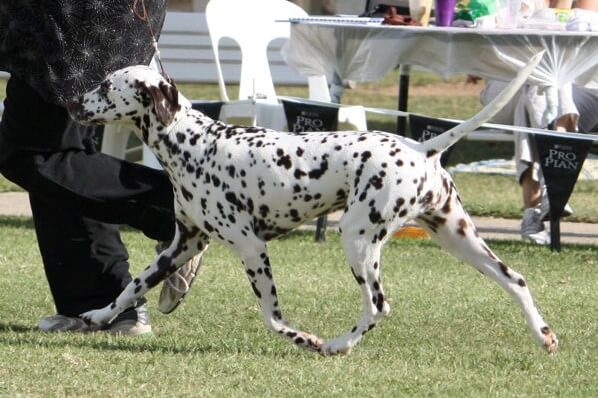More Than Just Their Spots – Judging the Dalmatian
Dalmatians are much more than their spots. Spotting is like the icing on a cake. It goes on last and helps to create a beautiful sight to behold. I say this up front because many new judges think that a Dalmatian’s spots are the most important feature of the breed. Quite the contrary.
The Dalmatian Club of America’s (DCA) Judge’s Education materials emphasize that there are three elements to correct Dalmatian type: 1. Body shape and symmetry; 2. Steady, effortless movement with reach and drive; 3. Spotting pattern. (A dog with a messy spotting pattern may have the best structure and movement, and shouldn’t be overlooked.)
Looking back at the Dalmatian’s history, we find a dog that is mentioned throughout history as a coach dog. To be a coach dog requires a dog that is capable of running long distances, a dog of great endurance combined with a fair amount of speed. To do this requires a strong, muscular, and active dog that is free of shyness.
If you can’t recognize a dog without spots as a Dalmatian, then something is definitely wrong with the shape, size, balance, and proportion of that Dalmatian.
One of the mental tests that I like to use when judging is to imagine the dogs without their spots. Does this “solid white” dog look like a different breed? Perhaps a Pointer, a Labrador, a Whippet, or something in between? If you can’t recognize a dog without spots as a Dalmatian, then something is definitely wrong with the shape, size, balance, and proportion of that Dalmatian.
The AKC Breed Standard requires overall length of body, from the forechest to the buttocks, to be approximately equal to the height at the withers. The topline is smooth and the chest is deep, with the brisket reaching to the elbow. The underline of the rib cage curves gradually into a moderate tuck-up. The back is level and strong, with the croup being nearly level with the back. The tail is a natural extension of the topline and is carried with a slight upward curve, but it should never curl over the back.
Deviations from the above description of the shape of a Dalmatian will result in a dog that starts looking like a different breed. Any dog over 24 inches tall at the withers is to be disqualified.
Most of the components of correct structure can be seen in the side gait of a Dalmatian. Balanced angulation fore and aft, combined with powerful muscles and good condition, produces smooth, efficient action. There should be powerful drive from the rear coordinated with extended reach in the front. The topline remains level while the dog is moving. Because of their natural “coaching” instinct, Dalmatians may drop their head while moving at a steady pace. The head carriage, topline, and tail carriage should create a continuous, smooth outline. This type of movement should be rewarded. Flashy, high head carriage, commonly seen in other breeds, is not correct, nor preferred, in the Dalmatian.
Most new judges probably worry too much about the color and markings of Dalmatians.
The Dalmatian is not a “head” breed. The head is in balance with the overall dog. Expression should indicate an alert, intelligent dog with a stable temperament. The Standard requires a scissors bite. Overshot or undershot bites are disqualified.
Most new judges probably worry too much about the color and markings of Dalmatians. Patches, tri-color, and any color other than black or liver are to be disqualified. In my twenty-five years of judging Dalmatians, I have never witnessed a true patch, tri-color, or any other-colored Dalmatian appear in a Conformation ring.
Patches are NOT run-together spotting. Tri-color is a pattern, as seen on a Bernese Mountain Dog, with tan markings on the face, chest, legs, or base of tail. Different shades of liver-brown do NOT constitute a tri-color. Tri-colors must have tan markings in addition to the black or liver spotting. Any other colors include lemon, orange, and blue, but these rarely occur within our breed.
Present-day Dalmatians that are being shown are exhibiting more color than in years past. Spotting patterns can range from very few spots to an overabundance of spots. Ideally, most breeders would prefer the patterns to be somewhere in the middle, with nicely placed, individual spots. A perfectly spotted dog, however, is not always the best Dalmatian in the ring.
I frequently get questions about dogs that appear to have solid black or solid liver ears. These ears are often confused with being a patch. When looking at a Dalmatian ear, I always suggest looking at the underside of the ear as well as the part that is visible. Check for white “guard hairs” or any evidence of what appears as faint outlines of spots that have run together. (This appears like veining in marble.) Dogs with solid-colored ears that contain a few white guard hairs are well within the Standard and should be judged on their overall merit and not ignored simply because of their dark ears.
Other overly spotted areas on the dog that might cause concern for newer judges can be the throat, neck, and underbelly. Spotting in these areas tend to run together. This is okay. When thinking of a patch, think about a Pointer or a German Shorthaired Pointer. Patches do not look like a cluster of spots that have run together and are touching. Patches are larger areas, with smooth edges, and do not contain white hair or white veining within the solid area.
Although the AKC Standard calls for dogs and bitches to be between 19-23 inches, any dog over 24 inches at the withers is to be disqualified. In reality, bitches are usually somewhat smaller than dogs. However, the Dalmatian has good substance, and is strong and sturdy in bone but never coarse. It is possible to have too much bone and substance; this would produce a dog that is too coarse. Conversely, refined bone would prevent a Dalmatian from being capable of great endurance.
Overall symmetry in outline, without exaggeration, is desirable. Shoulders are smoothly muscled and well laid-back. The upper arm is approximately equal in length to the shoulder blade and joins it at an angle sufficient to ensure that the foot falls under the shoulder. The hindquarters are powerful, with smooth yet well-defined muscles. The stifle is well bent.
Feet are very important. Both the front and rear feet are round and compact, and should have thick, elastic pads and well-arched toes. Flat feet and cow hocks are major faults, as they will affect the dog’s ability to have powerful, efficient movement.
I suggest, to anyone who wants to judge the Dalmatian, to first find the dogs that have the correct balance and shape. Then find the dogs that have a powerful, balanced side gait, including a level topline, while moving. Lastly, look for a spotting pattern that is within the boundaries of the Standard, and a pattern that is not distracting to you. When in doubt, remember the original purpose of the Dalmatian, and move them around the ring one more time. The really good ones should be easy to find. Dalmatians are much more than just their spots.










